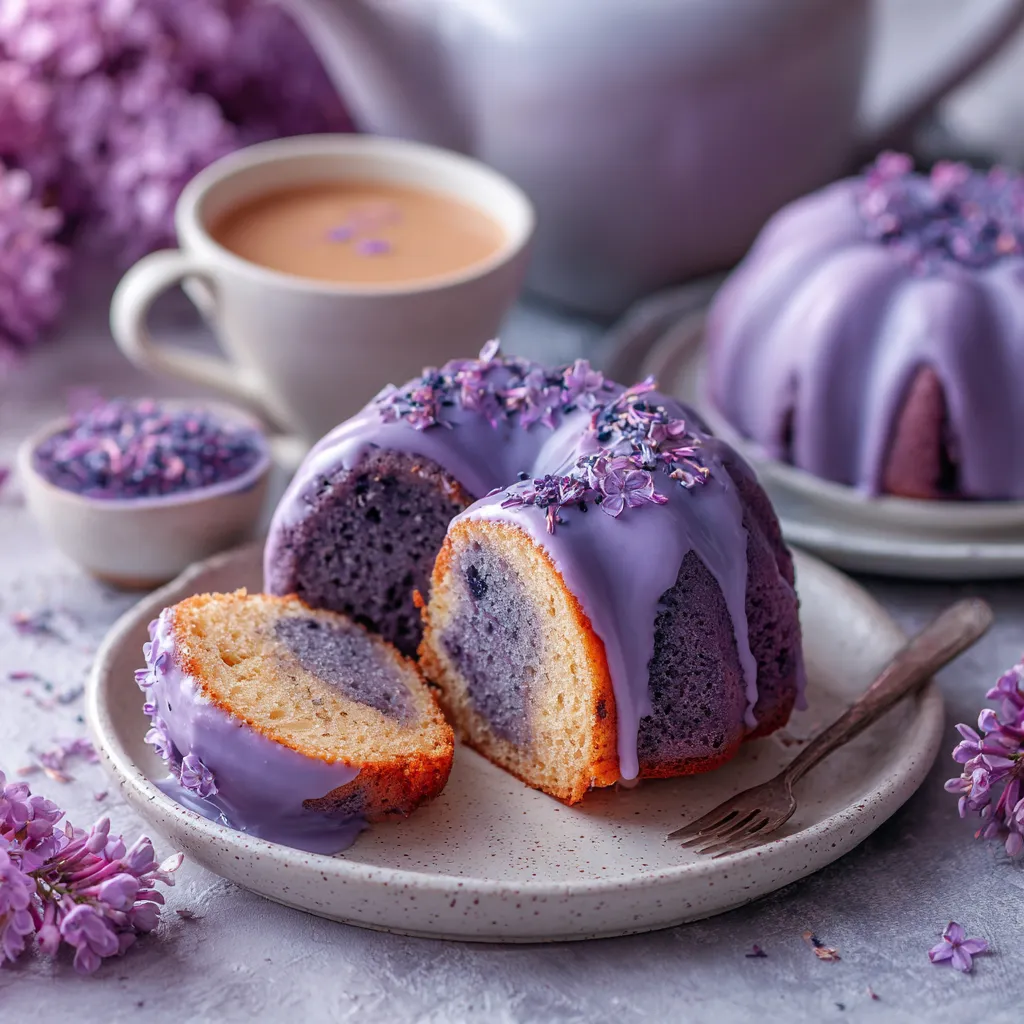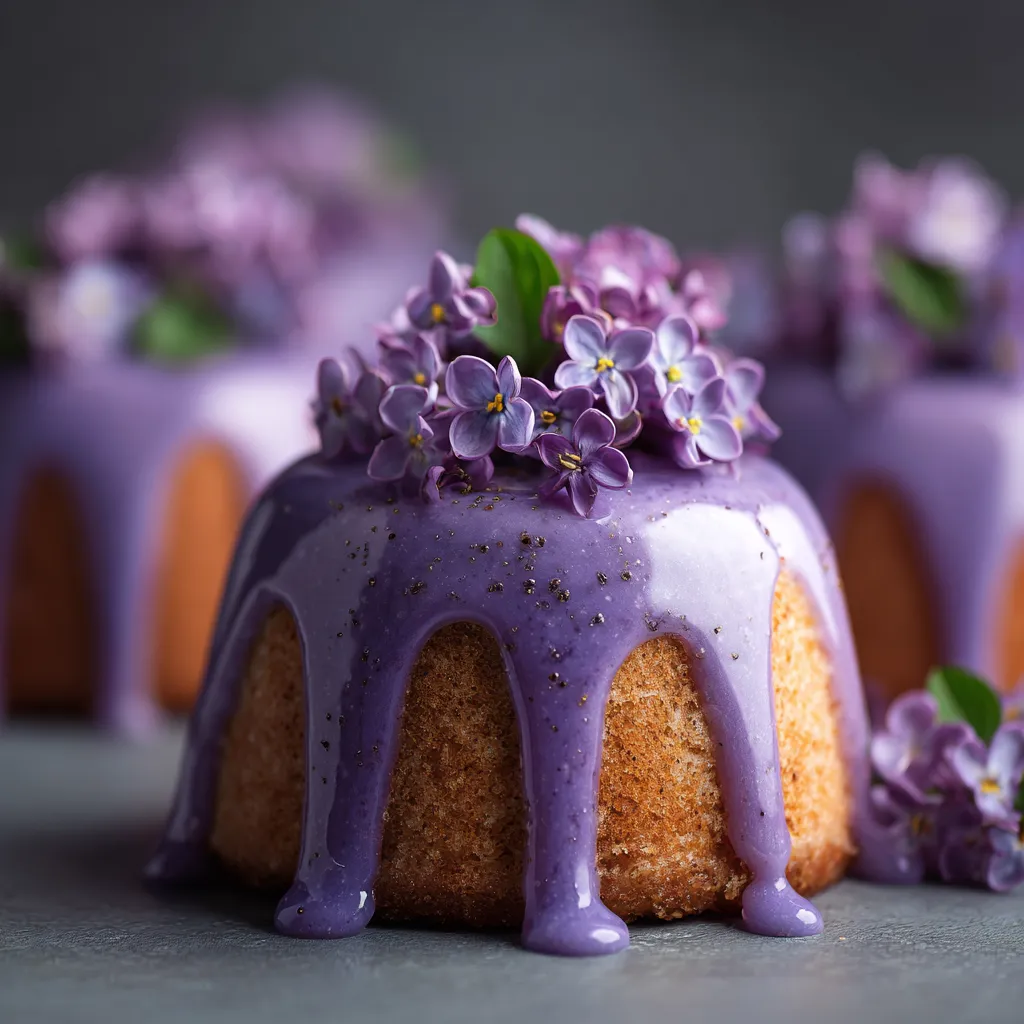 Save
Save
These mini lilac Bundt cakes celebrate the delicate floral notes of fresh spring blossoms paired with bright lemon and a light, aromatic glaze. Their soft crumb and beautiful aroma make them a unique show-stopper for spring gatherings or afternoon tea.
I fell in love with these mini Bundt cakes after baking them with my grandmother one May, when the lilacs in her garden were heavy with fragrance. The scent filled the kitchen and this recipe became a family tradition we look forward to each spring.
Ingredients
- Sugar: adds sweetness and helps create a tender crumb. Choose fine white granulated sugar for best mixing results.
- Fresh lilac blossoms: infuse a complex floral note. Make sure to use chemical-free blooms and pick only the petals to avoid bitterness.
- All-purpose flour: creates a sturdy yet soft cake structure. Scoop and level the flour to avoid packing.
- Baking powder and baking soda: work together for even rising and a delicate texture. Check dates for freshness
- Salt: balances the sweetness and heightens floral and citrus flavors.
- Milk: softens the crumb and keeps cake moist. Use whole milk for rich results.
- Lemon juice: sours the milk slightly, activating baking soda and adding brightness. Fresh squeezed is best.
- Butter: gives richness and a soft crumb. Room temperature butter creams best.
- Eggs: bind ingredients and add moisture for a lifted cake. Use large eggs at room temperature.
- For the syrup and glaze: use the finest lilac petals and icing sugar for a smooth finish. Violet food coloring offers a beautiful lavender hue. Use sparingly for a natural look.
Step-by-Step Instructions
- Prepare the Lilac Sugar:
- Pulse sugar and freshly picked lilac blossoms in a food processor. Aim for mostly broken petals but avoid turning to paste as this can dampen texture.
- Combine Dry Ingredients:
- In a separate bowl, whisk flour, baking powder, baking soda, and salt so each is evenly distributed. This improves rise and crumb.
- Sour the Milk:
- Mix milk and fresh lemon juice in a small cup. Allow it to rest until it thickens slightly. This sours the milk and boosts the floral tones.
- Cream Butter and Sugar:
- Beat softened butter with the prepared lilac sugar in a mixer using a paddle attachment. Scrape the bowl to ensure a uniform creamy texture.
- Incorporate Eggs:
- Add eggs one by one, mixing in between so each is fully absorbed. Proper mixing at this stage keeps the crumb tender.
- Alternate Dry and Wet Ingredients:
- Mix in one third of the flour mixture followed by half the soured milk, then repeat. Always start and end with flour for best batter consistency.
- Prepare the Pan and Fill:
- Generously spray your mini Bundt cake pan. Evenly drop batter into each well, using a spoon to fill the intricacies of the pan. Tap to remove air bubbles.
- Bake the Cakes:
- Bake at 350 degrees F for 20 to 25 minutes. Look for cakes that spring back to touch and a clean toothpick.
- Make Lilac Syrup:
- While baking, simmer water and sugar until dissolved. Remove from heat and add lilac blossoms to steep. Strain when cool and reserve some for the glaze.
- Glaze the Cakes:
- Mix icing sugar, reserved lilac syrup, milk, and a drop of violet coloring for a pourable glaze. Adjust with more sugar or milk as needed.
- Finish and Glaze:
- Brush warm cakes with syrup, allow to rest, then unmold and brush tops again. Once cool, drizzle glaze and let set.
 Save
Save
My favorite part is the lilac sugar which perfumes the entire kitchen as you blend it. My oldest daughter loves to help sprinkle lilac petals and has made a game of guessing how purple we can make the glaze each time we bake these.
Storage Tips
Mini Bundt cakes keep best in an airtight container at room temperature for up to two days. Refrigerate if your kitchen is warm, but always allow them to return to room temperature before serving for softest texture. The glaze will keep cakes from drying out for several days.
Ingredient Substitutions
If lilac blossoms are out of season or hard to find safe to use dried lavender instead. You only need about two tablespoons since lavender is more concentrated. For a fun twist orange blossom water or lemon zest can also be mixed in for a bright aroma.
Serving Suggestions
These mini Bundt cakes dress up beautifully for holidays or brunch. Add fresh edible flowers for a dramatic touch on a cake tray. They pair especially well with cold lemonade or delicate teas.
Cultural and Historical Notes
Lilac-flavored sweets have a long tradition in European kitchens especially in early summer when the blossoms are at their peak. Baking with edible flowers brings a celebration of spring’s fleeting beauty straight to your table.
Recipe FAQs
- → How do you prepare lilac blossoms for baking?
Pick blossoms from the stem, remove leaves and stems, then gently rinse and dry before using in the batter or syrup.
- → Can I substitute lilac with another edible flower?
Yes, dried lavender buds work well as an alternative to lilac blossoms, providing a similarly floral note.
- → Why brush the cakes with floral syrup?
Brushing with syrup enhances moisture and infuses more of the delicate lilac flavor into each cake.
- → What pan size is best for this method?
Mini bundt pans are ideal, but you can also scale the recipe for one small or standard bundt cake pan as needed.
- → How do I know when the mini cakes are baked through?
The tops should spring back when touched and a toothpick inserted should come out clean.
